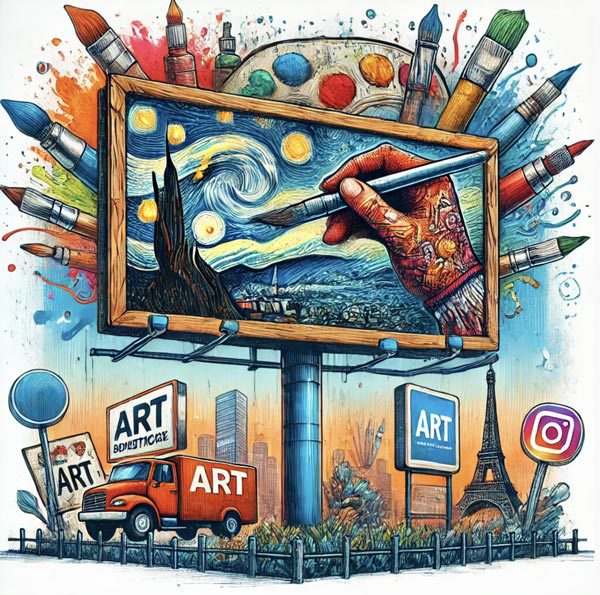
Art and advertising have always had a complicated relationship. At its best, advertising is a vehicle for creative expression, blending artistic elements with strategic messaging to captivate audiences. Yet, at its worst, it is seen as a sellout, exploiting creativity to push products. This tension raises an important question: Is art in advertising a celebration of creativity, or is it merely a tool for corporate profit? Let’s delve into this multifaceted debate.
Historical Perspective
The intersection of art and advertising isn’t a recent phenomenon. In the early days of advertising, artistic elements were often employed to attract attention and create a memorable impression. Think of the beautiful hand-drawn posters of the late 19th and early 20th centuries. These early advertisements were more than just marketing tools; they were pieces of art that people admired and sometimes even collected.
As technology advanced, so did the mediums through which advertisements were delivered. The advent of radio and television introduced new opportunities for artistic expression. Suddenly, advertising wasn’t just about static images; it was about creating engaging audio-visual experiences. This period saw a blossoming of creativity, with jingles, animations, and innovative cinematography becoming integral parts of advertising campaigns.
Despite these advancements, the core purpose of advertising remained the same: to sell products. However, the methods became more sophisticated and nuanced. Artistic elements were not just add-ons but essential components of successful campaigns. Brands began to realize that a well-crafted ad could do more than just inform; it could evoke emotions and create lasting impressions.
Today, the history of art in advertising serves as a testament to its evolving nature. From the early days of print to the digital age, the relationship between art and advertising has continually adapted, reflecting broader cultural and technological changes. This historical perspective sets the stage for understanding how art functions in modern advertising.
The Role of Art in Modern Advertising
In contemporary advertising, art plays a crucial role in capturing and maintaining consumer attention. In a world inundated with ads, it is the artistic quality that often distinguishes memorable campaigns from the forgettable ones. Art in advertising is not just about aesthetics; it’s about creating a brand identity that resonates with the audience on a deeper level.
One of the primary purposes of incorporating art into advertising is to enhance brand identity. Artistic elements can convey a brand’s values, personality, and ethos in a way that words alone cannot. For example, the minimalist design of Apple’s ads reflects the brand’s commitment to simplicity and elegance. Similarly, the vibrant and playful visuals in Coca-Cola’s advertisements evoke a sense of joy and togetherness, aligning with the brand’s image.
Various artistic techniques are employed in advertising to achieve these effects. Surrealism, for instance, can create a dream-like atmosphere that captivates viewers and leaves a lasting impression. Minimalism, on the other hand, uses simplicity to highlight the essential features of a product, making it more appealing. Abstract art can evoke emotions and provoke thought, encouraging viewers to engage with the ad on a more personal level.
Successful ad campaigns often serve as prime examples of how art can elevate advertising. Consider the “Think Different” campaign by Apple, which celebrated creativity and innovation. The campaign’s striking visuals and inspiring message not only promoted Apple products but also reinforced the brand’s association with creative thinking and technological advancement. These examples illustrate how art in advertising is not just about creating beautiful images but about crafting compelling narratives that resonate with consumers.
Creative Expression in Advertising
For many artists and designers, advertising offers a unique platform for creative expression. Unlike traditional art forms that may reach a limited audience, advertisements have the potential to be seen by millions of people. This widespread visibility provides artists with an opportunity to showcase their work and influence popular culture.
Artists often use advertising as a canvas to explore new ideas and push creative boundaries. Iconic artists like Andy Warhol and Salvador Dalí made significant contributions to the world of advertising, infusing their unique styles into commercial campaigns. Warhol’s work for brands like Campbell’s Soup blurred the lines between fine art and advertising, while Dalí’s collaboration with companies like Chupa Chups showcased his surrealist flair in a commercial context.
Case studies of ad campaigns celebrated for their artistic merit further illustrate this point. Nike’s “Just Do It” campaign, for example, is renowned not only for its powerful message but also for its visually striking design. The campaign’s use of bold colors, dynamic compositions, and evocative imagery exemplifies how artistic elements can enhance the impact of an advertisement.
These examples highlight the potential for advertising to serve as a legitimate form of artistic expression. By incorporating creative elements into their campaigns, brands can create ads that are not only effective but also culturally significant. This fusion of art and commerce challenges the notion that advertising is merely a tool for selling products, demonstrating its potential to contribute to the broader artistic landscape.
The Corporate Influence
Despite the potential for creative expression, the influence of corporate objectives on art in advertising cannot be overlooked. At its core, advertising is a commercial endeavor designed to drive sales and promote brand awareness. This reality often means that artistic choices are guided by strategic considerations, balancing creativity with commercial viability.
Corporate goals can sometimes constrain artistic freedom, leading to a tension between creativity and commercialism. Advertisers must ensure that their campaigns resonate with target audiences, align with brand values, and ultimately contribute to business objectives. This need for strategic alignment can limit the extent to which artists can experiment and innovate within the confines of a commercial campaign.
Critics of art in advertising often argue that it represents a sellout of artistic integrity. They contend that the primary purpose of advertising is to manipulate consumer behavior and generate profit, which can undermine the authenticity and originality of the artistic elements. This perspective is exemplified by the backlash against certain campaigns that are perceived as overly commercial or inauthentic.
Quotes from critics and artists who oppose the commercialization of art further underscore this point. For instance, the renowned street artist Banksy has famously criticized the use of art in advertising, arguing that it exploits creativity for corporate gain. Such critiques highlight the ethical dilemmas and potential compromises involved in blending art with advertising.
However, it is important to recognize that the relationship between art and corporate influence is not inherently negative. While commercial objectives can shape artistic choices, they can also drive innovation and inspire new forms of creative expression. The challenge lies in finding a balance that allows for both artistic integrity and commercial success.
Blurring the Lines
In recent years, the lines between art and advertising have become increasingly blurred. Collaborations and partnerships between brands and artists have resulted in some of the most innovative and memorable ad campaigns. These collaborations often involve a mutual exchange of ideas, with artists bringing their unique perspectives to the table and brands providing the resources and platform for creative expression.
Successful partnerships demonstrate the potential for synergy between art and advertising. For example, the collaboration between Louis Vuitton and contemporary artist Jeff Koons resulted in a series of visually stunning ad campaigns that celebrated both the brand’s luxury heritage and Koons’ artistic vision. Similarly, Adidas’ collaboration with artist Pharrell Williams produced a range of colorful and culturally resonant advertisements that resonated with a global audience.
These examples illustrate how advertising can serve as a fertile ground for artistic experimentation and innovation. By working together, brands and artists can create campaigns that are not only commercially successful but also culturally impactful. This collaborative approach challenges the traditional boundaries between art and commerce, highlighting the potential for mutually beneficial relationships.
The grey area between pure art and commercial content raises interesting questions about consumer perception. Do audiences view these blended forms as genuine artistic expressions, or do they see them as cleverly disguised marketing tactics? The answer often depends on the execution and the perceived authenticity of the collaboration. When done well, these campaigns can elevate both the brand and the artist, creating a win-win scenario.
The Future of Art in Advertising
Looking ahead, technological advancements are poised to transform the role of art in advertising. Emerging technologies such as artificial intelligence, virtual reality, and augmented reality offer new possibilities for creative expression. These tools enable brands to create immersive and interactive experiences that engage audiences in innovative ways.
For example, virtual reality allows advertisers to create fully immersive environments that consumers can explore, blurring the lines between reality and imagination. Augmented reality, on the other hand, can overlay digital elements onto the physical world, creating a seamless blend of art and technology. These advancements open up exciting new avenues for artistic expression, pushing the boundaries of what is possible in advertising.
Sustainability and ethics are also becoming increasingly important considerations in advertising. Consumers are more conscious than ever about the social and environmental impact of the brands they support. This shift is driving a demand for more responsible and ethical advertising practices, which in turn is influencing the artistic direction of ad campaigns.
Brands that prioritize sustainability and ethical values are finding new ways to incorporate these principles into their advertising. This trend is leading to the creation of ads that not only promote products but also advocate for positive social and environmental change. The fusion of art and ethics in advertising represents a promising direction for the future, demonstrating that creativity can be harnessed for the greater good.
Conclusion
The debate over whether art in advertising is a celebration of creativity or a corporate sellout is complex and multifaceted. On one hand, advertising provides a platform for artists to reach wide audiences and explore new creative possibilities. On the other hand, the commercial objectives of advertising can sometimes constrain artistic freedom and authenticity.
Ultimately, the relationship between art and advertising is a dynamic and evolving one. It reflects broader cultural, technological, and economic trends, continually adapting to new challenges and opportunities. As we look to the future, it is clear that art will continue to play a vital role in shaping the world of advertising, offering endless possibilities for creative expression and innovation.




